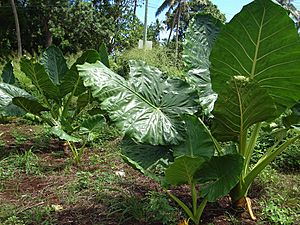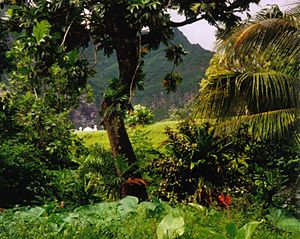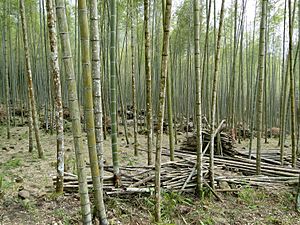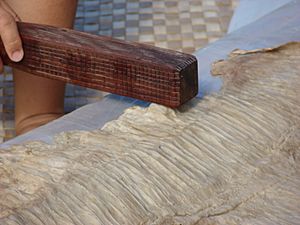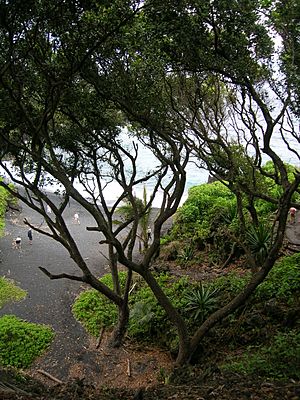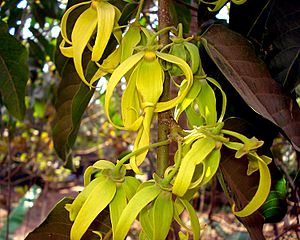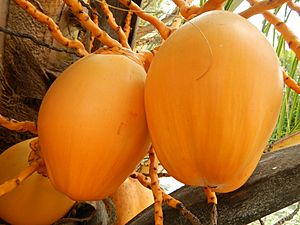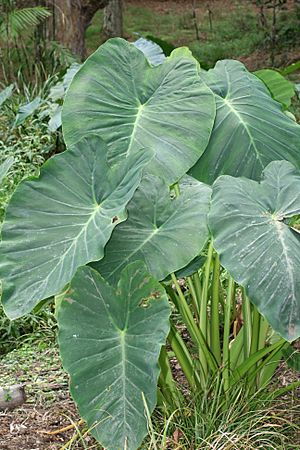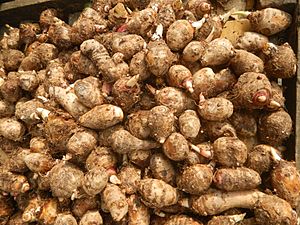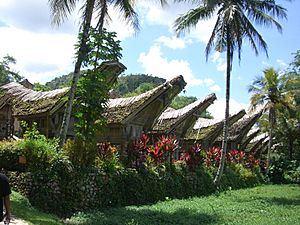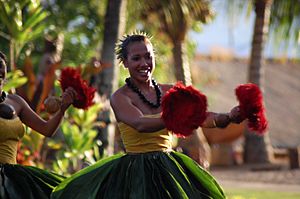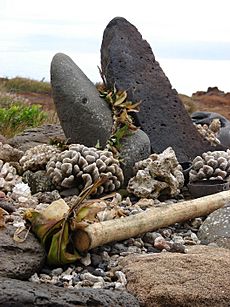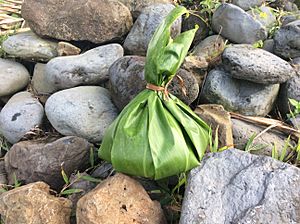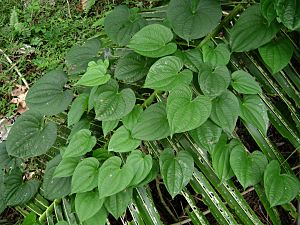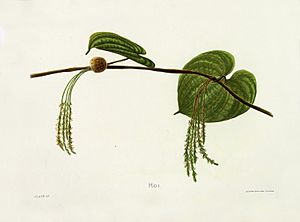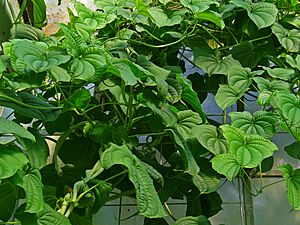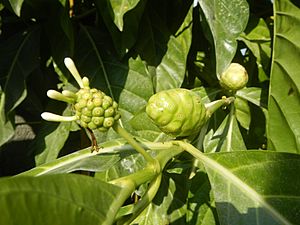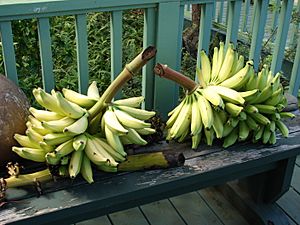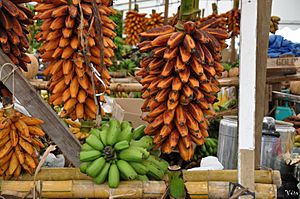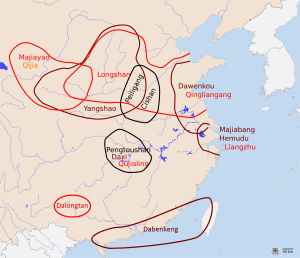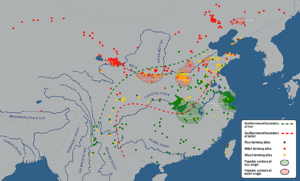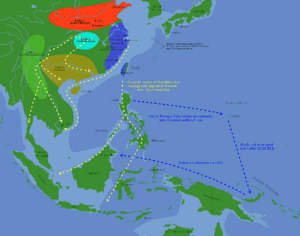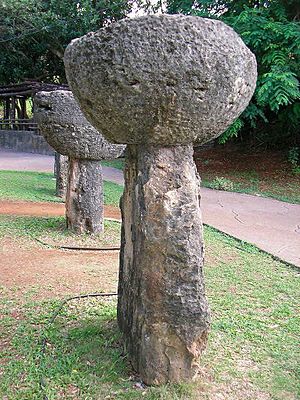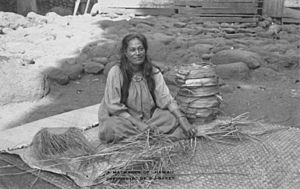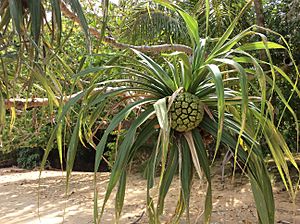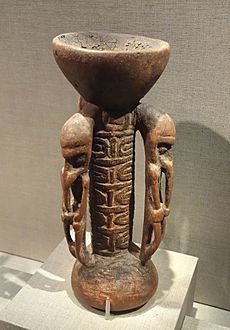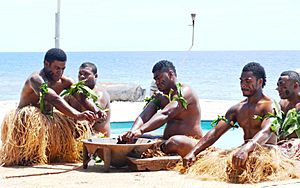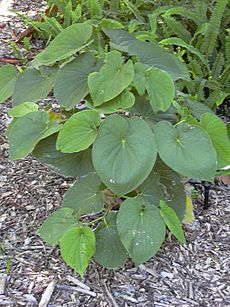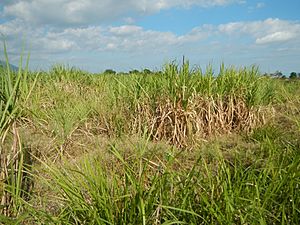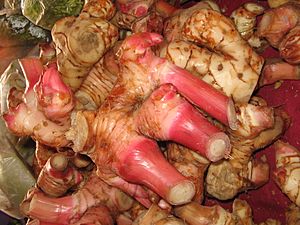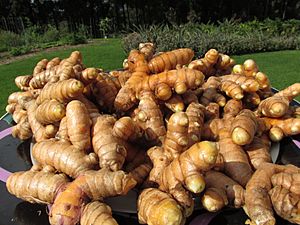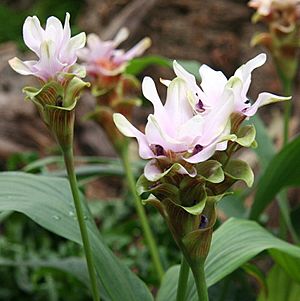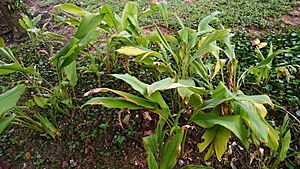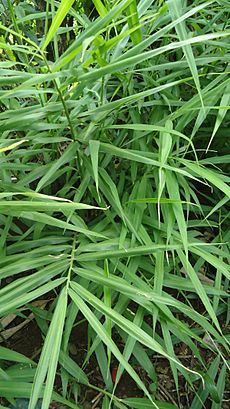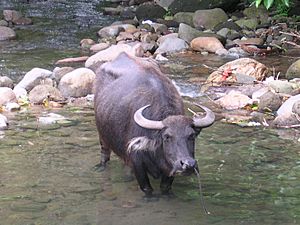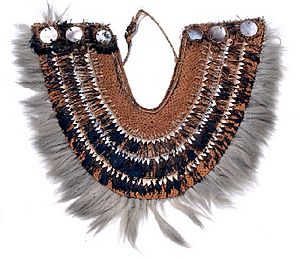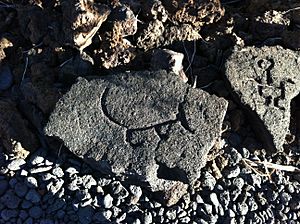Domesticated plants and animals of Austronesia facts for kids
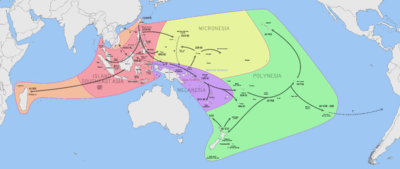
Long ago, people called the Austronesian peoples made amazing journeys across the Indo-Pacific Ocean. They started these trips about 5,500 to 4,000 years ago. These brave sailors used special canoes and catamarans. They brought along important plants and animals that helped them live and grow in new places. These places included islands in Maritime Southeast Asia (like the Philippines and Indonesia), Melanesia, Micronesia, Polynesia, Madagascar, and the Comoros Islands.
The plants and animals they carried were very important for their survival. Some came from ancient cultures in mainland China. Others were first grown in Taiwan, Island Southeast Asia, or New Guinea. Some of these plants are even called "canoe plants" because they traveled with the people in their canoes. We'll only talk about the plants and animals that were important before modern times.
Contents
- Plants Carried by Austronesian Voyagers
- Candlenut (Aleurites moluccanus)
- Giant Taro (Alocasia macrorrhizos)
- Elephant Foot Yam (Amorphophallus paeoniifolius)
- Artocarpus Trees (Breadfruit and Jackfruit)
- Bamboos (Bambusoideae)
- Wax Gourd (Benincasa hispida)
- Paper Mulberry (Broussonetia papyrifera)
- Mastwood (Calophyllum inophyllum)
- Ylang-ylang (Cananga odorata)
- Citrus Fruits
- Coconut (Cocos nucifera)
- Taro (Colocasia esculenta)
- Beach Cordia (Cordia subcordata)
- Ti Plant (Cordyline fruticosa)
- Yams (Dioscorea species)
- Fig Trees (Ficus species)
- Sweet Potato (Ipomoea batatas)
- Bottle Gourd (Lagenaria siceraria)
- Noni (Morinda citrifolia)
- Bananas (Musa species)
- Rice (Oryza sativa)
- Pandan (Pandanus species)
- Peppers (Piper species)
- Sugarcane (Saccharum species)
- Pacific Rosewood (Thespesia populnea)
- Ginger Family (Zingiberaceae)
- Animals Carried by Austronesian Voyagers
- Images for kids
- See also
Plants Carried by Austronesian Voyagers
Austronesian travelers carried many useful plants with them. These plants helped them settle and thrive on new islands.
Candlenut (Aleurites moluccanus)
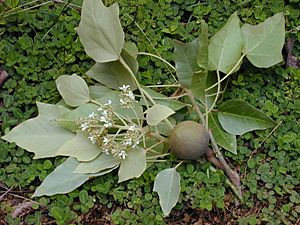
The candlenut tree was first grown in Island Southeast Asia. People found old candlenuts in places like Timor and Morotai in Indonesia, dating back 11,000 to 13,000 years. It was also grown in Sulawesi about 3,700 to 2,300 years ago. Austronesian sailors took candlenut trees to many Pacific Islands. They grew well on volcanic islands.
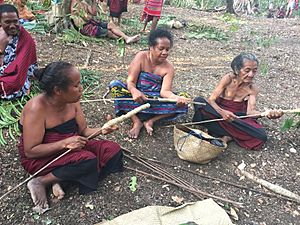
Candlenut trees are super useful! People used the nuts for their high oil content. Before electric lights, they used candlenuts as torches. They would skewer the nuts on coconut leaf stems and light them. Each nut burned for about three minutes, making a long-lasting light. This tradition still exists today. The oil from the nuts was also used in lamps, soaps, and even to protect fishing gear. The wood was used for small canoes and carvings. The nut shells became decorations or fish-hooks. The bark was used for medicine and fiber. Some types of candlenuts are even used in cooking!
Giant Taro (Alocasia macrorrhizos)
Giant taro first came from the Philippines. Wild types were known in Taiwan. From the Philippines, it spread across Island Southeast Asia and into Oceania. It became a main food source for Pacific Islanders. Giant taro is one of four main types of taro plants grown by Austronesians for their starchy roots. The leaves and stems can be eaten if cooked well, but this is rare because they can cause itching.
Elephant Foot Yam (Amorphophallus paeoniifolius)
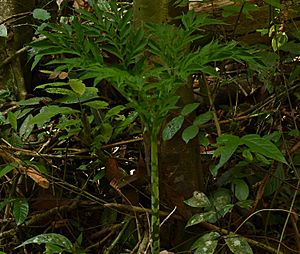
Elephant foot yam is eaten in Island Southeast Asia, Mainland Southeast Asia, and South Asia. It was once thought to come from India. But new studies show it likely started in Island Southeast Asia. From there, it spread west to Thailand and India, and east to Madagascar, New Guinea, and Oceania with the Austronesians.
This yam is another starchy root crop. It's one of the four main taro-like plants grown by Austronesians. However, it was probably mostly eaten when other foods were scarce, as it can cause irritation if not cooked thoroughly.
Artocarpus Trees (Breadfruit and Jackfruit)
Many Artocarpus trees are grown or gathered in Island Southeast Asia and Micronesia. People use them for food, wood, and medicine. Important types include breadfruit and jackfruit.
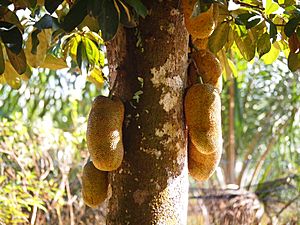
Breadfruit (Artocarpus altilis)
The wild ancestor of breadfruit is the breadnut (Artocarpus camansi). It comes from New Guinea, the Maluku Islands, and the Philippines. People in Polynesia carefully bred breadnut to create the breadfruit we know today, which usually has no seeds. Breadfruit in Micronesia also mixed with a local tree, Artocarpus mariannensis. This shows that Micronesia was settled in a slightly different way than Polynesia and Melanesia.
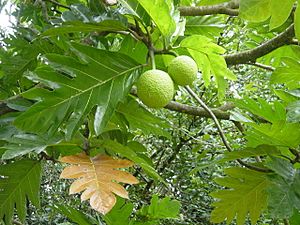
The word for breadfruit in many old languages is *kuluʀ. This became *kulur in Oceanic languages and *kulu in Polynesian languages. Modern names include kulur or kelur in Malay, and ʻulu in Hawaiian. In Māori, the word kuru is only in old stories, because breadfruit did not grow in Aotearoa (New Zealand).
Jackfruit (Artocarpus heterophyllus)
Jackfruit was grown in both South Asia and Southeast Asia independently. It was likely first grown by Austronesians in Java or the Malay Peninsula. The old word for jackfruit in Western Malayo-Polynesian was *laŋkaq. Modern names include nangka in Malay and Javanese, and langka in Tagalog. Jackfruit was only brought to Guam more recently by Filipino settlers.
Bamboos (Bambusoideae)
Many kinds of bamboo grow across Island Southeast Asia, East Asia, and South Asia. Austronesian people used bamboo for building, fishing, music, and even as knives or containers for food and water. Bamboo shoots are also eaten. Some bamboo species were carried by Austronesian settlers to the Pacific islands. These include ʻohe (Schizostachyum glaucifolium), common bamboo (Bambusa vulgaris), and thorny bamboo (Bambusa bambos).
Old words for bamboo include *qauR and *kawayan. In Polynesia, many words for bamboo come from *kofe. Modern names include kofe in Tongan and ʻohe in Hawaiian. Sometimes, these names now refer to other bamboo-like plants, especially where bamboo didn't grow well.
Wax Gourd (Benincasa hispida)
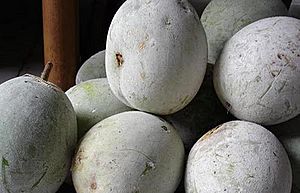
Paper Mulberry (Broussonetia papyrifera)
Paper mulberry, also known as the "tapa cloth tree," comes from mainland Asia. Its spread is strong proof of the "Out of Taiwan" idea for the Austronesian expansion. Studies show that paper mulberry in the Pacific came from Taiwan, through New Guinea and Sulawesi. In the Philippines, paper mulberry plants today are mostly from modern introductions, suggesting older ones died out. This plant usually needs people to grow it.
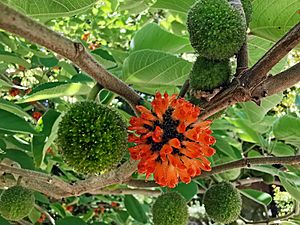
This was likely the most transported fiber plant in ancient times. It traveled with Austronesians across their entire journey, even to Rapa Nui and Aotearoa. Some populations died out when people stopped growing them. Polynesians spread it by planting cuttings, not usually from seeds.
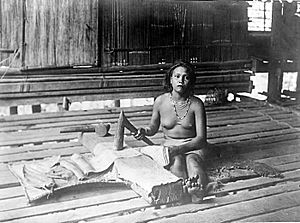
Paper mulberry was mainly used in the Pacific Islands to make barkcloth (called tapa in many Polynesian languages). Barkcloth could also be made from other trees like fig trees. But the best quality barkcloth came from paper mulberry.
Ancient Austronesians used barkcloth for clothing. They made it by pounding the bark with special stone or wooden tools. These tools are often found in old Austronesian sites. Barkcloth was important for clothing in Melanesia, Polynesia, and parts of Indonesia before Europeans arrived. But in most of Island Southeast Asia and Micronesia, woven fabrics replaced it.
Many names exist for paper mulberry. A common old word is *malaw, which also meant the loincloth made from the bark. In Eastern Polynesia, another old word is *aute. In Polynesia, the word for barkcloth is often *taba, meaning "bark." This became tapa in Samoan and kapa in Hawaiian.
Mastwood (Calophyllum inophyllum)
Mastwood is a large timber tree found in tropical Asia. It grows huge on beaches and coasts, with big branches reaching over the water. Its seeds float, spreading naturally. Mastwood was very important for building the large Austronesian outrigger ships. Austronesians carried it with them to Oceania and Madagascar.
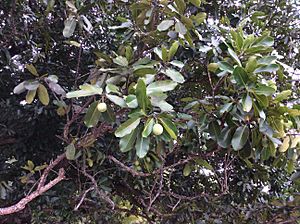
Other similar trees were also used. Their wood is strong and good for carving. They were as important as oak trees were for European shipbuilding. In Polynesia, mastwood groves near sacred places were thought to be homes for spirits. Mastwood was also carved into religious objects.
Different parts of the mastwood tree were used for canoes. The big curved branches were carved into the main body of the canoe. Other parts became masts, outrigger floats, and spars. The oil from the fruit kernels, called tamanu oil, was also important in Polynesian culture. It was used in traditional medicine. The leaves could even be used to stun fish.
Ylang-ylang (Cananga odorata)
Ylang-ylang has large, sweet-smelling flowers. It was used for decoration. This plant came from the Philippines. It's not clear if it was native to Polynesia and Melanesia or if people brought it there.
Citrus Fruits
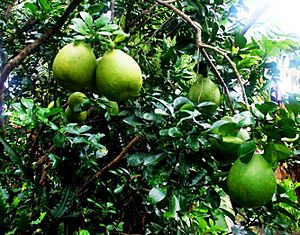
Many types of citrus trees grow naturally in Island Southeast Asia, East Asia, and Near Oceania. Austronesians grew and gathered citrus for food, medicine, and washing. The thorns were even used for tattooing. Some citrus types, like Citrus hystrix, Citrus macroptera, and Citrus maxima (pomelo), were carried by Austronesian sailors to Micronesia and Polynesia.
Coconut (Cocos nucifera)
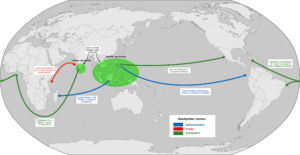
Coconuts first came from the area between Southwest Asia and Melanesia. There are two main types of coconuts: one from Island Southeast Asia (Pacific group) and one from India (Indo-Atlantic group). The Pacific group shows clear signs of being domesticated, like being smaller and self-pollinating. The spread of Pacific coconuts matches where Austronesian sailors traveled, showing that people spread them.
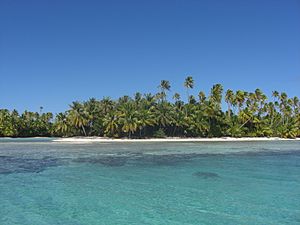
For example, in Madagascar, settled by Austronesian sailors about 2,000 to 1,500 years ago, the coconuts there are a mix of both types. This means Pacific coconuts were brought by Austronesians and mixed with local Indian Ocean coconuts.
Most words for "coconut" in Austronesian languages come from the old word *niuʀ. Modern names include niyog in Tagalog and niu in Hawaiian and Samoan.
Studies of coconuts also show that coconuts were in Panama, South America, before Columbus arrived. These coconuts are most like those from the Philippines. This suggests that Austronesian sailors might have traveled to the Americas about 2,250 years ago. This idea is also supported by the presence of sweet potatoes in Oceania before Europeans.
Taro (Colocasia esculenta)
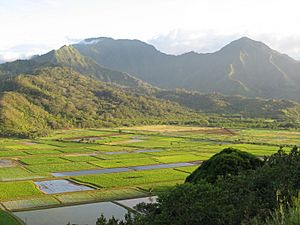
Taro, sometimes called "true taro," is one of the oldest cultivated crops. It was grown even before the Austronesian expansion. Taro grows in many tropical areas. It's believed to have been domesticated many times in places like New Guinea, Mainland Southeast Asia, and India.
Old traces of taro have been found in places like the Niah Caves in Borneo (over 40,000 years ago) and Kuk Swamp in New Guinea (over 10,000 years ago). This shows people were using taro for a very long time.
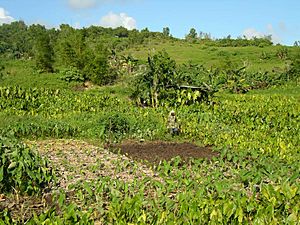
Taro was definitely a cultivated plant for Austronesians. In Island Southeast Asia, rice became more important, but taro was still grown. It remained a main food in Melanesia and Polynesia, where rice was not introduced. Taro is the most important and preferred of the four main starchy root crops grown by Austronesians, as it's less likely to cause irritation.
Taro was also a staple in Micronesia. Because many Micronesian islands are low-lying atolls, people dug pits and filled them with compost to grow taro. Old taro remains have been found in Lapita culture sites, dating back about 3,050 to 2,500 years ago.
The English name "taro" comes from Polynesian names.
Beach Cordia (Cordia subcordata)
Beach cordia is an important timber tree. Its wood is light and soft, perfect for carving tools, cups, bowls, and other items. It has no taste, so it was often used for food containers. The wood is also flammable and used for firewood. In some cultures, it was used for paddles and boat keels. Its seeds can be eaten in times of hunger. Other parts were used for medicine and dyes. Like mastwood, beach cordia was often planted in sacred places. It has cultural meaning in places like Kiribati and the Karimunjawa Islands. In Hawaii, people planted it around houses and made leis from its bright orange flowers.
Beach cordia grows well in sandy or rocky soil. It's common in coastal forests. It was once thought to be introduced, but it's now known to be native to most Indo-Pacific islands. However, people still deliberately planted it on some islands, especially in Micronesian atolls.
Ti Plant (Cordyline fruticosa)
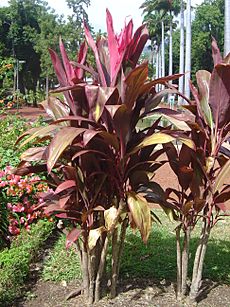
The ti plant looks like a small palm tree, growing up to 3 to 4 meters tall. It has beautiful fan-like leaves that can be red, green, yellow, or mixed colors. Its original home is unknown, but it's found from Bangladesh to New Guinea and Australia. It has the most variety in New Guinea, where it was likely grown a lot.
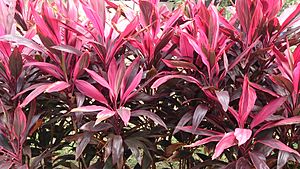
Austronesians carried ti plants across Oceania, reaching as far as Hawaii, New Zealand, and Easter Island. A special type of ti in Polynesia has large green leaves and big edible roots. This type is almost sterile in eastern Polynesia, meaning it can only be grown from cuttings. This might be because people carefully selected it for its larger, less fibrous roots, which were better for food.
Ti plants have many uses. They are very important in the traditional religions of Austronesian people. Many cultures believe they have magical or spiritual powers. They are often seen as sacred. People believe they can hold souls, help heal illnesses, and protect against bad spirits. They are used in rituals and worn as decorations. Red and green ti plants often represent different things, like war and peace. They are also used for medicine, dye, and decoration.
In Polynesia, the leaves of green ti were used to wrap food and line earth ovens. Their roots were harvested and made into a sweet paste or liquid. In Hawaii, the roots were even fermented into an alcoholic drink. Fibers from the leaves were used for ropes and bird traps. Eating ti as food, which was once forbidden because it was sacred, is thought to be a brave new idea by Polynesians when food was scarce.
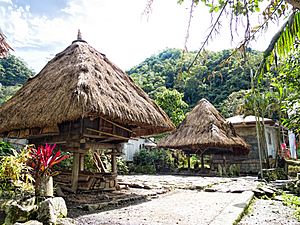
In the Philippines, ti plants were used by shamans for healing rituals. People believed the plant could host spirits. The Ifugao people planted it around their rice terraces to keep evil spirits away and mark land boundaries. Red leaves were thought to attract spirits and were worn during important rituals.
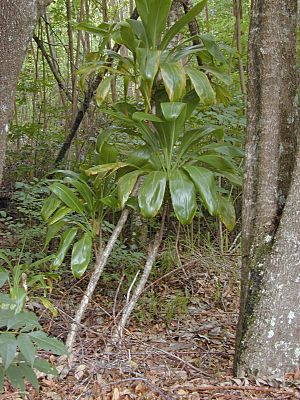
In Indonesia, red ti plants were used similarly. Many groups used them to ward off evil spirits and mark boundaries. They were also used in healing and funerals. The Dayak people even made a green dye from ti.
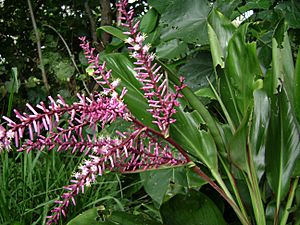
In New Guinea, ti plants marked land ownership and were planted around ceremonial houses. They are linked to blood and warfare. Some groups believed they housed "red spirits" of fallen warriors. In Island Melanesia, ti plants are sacred and used for protection, fortune-telling, and fertility. Red ti is linked to feuds, while green ti is linked to ancestor spirits.
In Micronesia, ti leaves were buried under new houses to protect against bad magic. Shamans used them to talk to spirits of the dead.
In Polynesia, green ti was grown for food and religious reasons. It was planted around homes, sacred places, and graves. People carried leaves as charms and used them in rituals to talk to spirits. They believed ti protected against evil and bad luck.
In ancient Hawaii, ti was very spiritual. Only priests and chiefs could wear its leaves during rituals. Ti was sacred to the gods Lono and Laka. Ti leaves were used for leis, to mark property lines, and to keep evil spirits away from homes. Hawaiians still plant ti for good luck. The leaves were also used for lava sledding and to make skirts for hula dancers.
In Aotearoa (New Zealand), some place names come from ti. The ti plants in Kaingaroa are called "phantom trees" from a legend about two women who turned into ti plants.
Yams (Dioscorea species)
Yams are a large group of plants with starchy roots, found in tropical and warm areas. Different types of yams were grown in Island Southeast Asia and New Guinea for their edible tubers. These include ube (Dioscorea alata), lesser yam (Dioscorea esculenta), and others. Some yams were only eaten in times of hunger because they contained toxins that needed careful preparation.
Ube and lesser yam were the easiest to transport on Austronesian ships. They were carried across most of the Austronesian expansion, including to the Pacific Islands, New Zealand, Madagascar, and the Comoros.
Ube (Dioscorea alata)
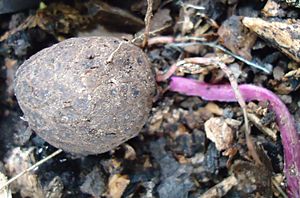
Ube, also called greater yam, is a very important food in Austronesian cultures. It's grown because of its large tubers and easy preparation. Its origin is unknown, but old evidence shows it was used in Island Southeast Asia and New Guinea before the Austronesian expansion. Ube is a cultivated plant, meaning it only exists because people grow it. It can't spread across water on its own, so its presence on islands shows human travel.
Some think ube was first grown in New Guinea about 10,000 years ago. It then spread to Island Southeast Asia. However, much older remains of ube have been found in the Niah Caves in Borneo (over 40,000 years ago) and Ille Cave in Palawan (about 11,000 years ago). This shows people knew how to use starchy plants very early.
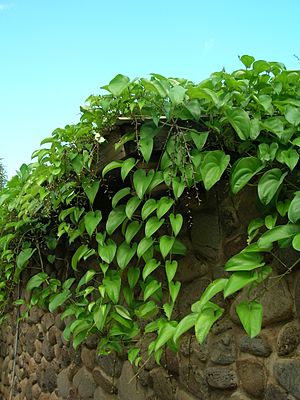
Ube is still important in Southeast Asia, especially in the Philippines, where the purple variety is used in many desserts. It's also important in Melanesia for food and ceremonies. Its importance in eastern Polynesia and New Zealand decreased after other crops, like sweet potato, were introduced.
The old word for ube, *qubi, is very common in Austronesian languages. Modern names include úbi or úbe in Tagalog, and ʻufi in Tongan.
Air Yam (Dioscorea bulbifera)
The air yam, also called bitter yam, is less commonly grown. It was usually only eaten as a "famine food" in Island Southeast Asia, Melanesia, and Polynesia. This is because some wild plants are toxic if not cooked properly. However, it was one of only three yams carried by Austronesians to distant Oceania. The part eaten is the aerial tubers, which grow above ground.
Lesser Yam (Dioscorea esculenta)
The lesser yam is the second most important yam crop for Austronesians. Like ube, it needs little preparation. However, its tubers are smaller and often spiny. It was brought to Madagascar and the Comoros by Austronesians. It's also a main crop in Near Oceania. But it didn't reach the furthest islands in Polynesia, like Hawaii and New Zealand.
Old remains of lesser yam have been found in Lapita culture sites in Fiji, dating back about 3,050 to 2,500 years ago. It's believed to have been introduced to New Guinea by the Lapita culture around 4,000 years ago.
Fig Trees (Ficus species)
Ficus is a large group of trees, shrubs, and vines, known as fig trees or figs. They grow in tropical areas. Many species are native to Austronesian regions and were important in their cultures.
Ficus dammaropsis
Ficus dammaropsis, called kapiak in Tok Pisin, is a tropical fig with huge leaves, found in the highlands of New Guinea. Its fruit is edible, but rarely eaten except in emergencies. Young leaves are sometimes pickled or boiled and eaten with pork.
Ficus nota
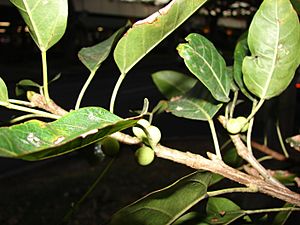
Ficus nota, also called tibig, grows near water at low altitudes. It's native to the Philippines and parts of northern Borneo. The tree can grow up to 9 meters tall.
Its fruits are edible but don't have much taste. They are often eaten with sugar and cream in the Philippines. The raw leaves are also eaten as a vegetable.
Ficus pseudopalma
Ficus pseudopalma, known as Philippine fig or palm leaf fig, is only found in the Philippines, especially on the island of Luzon.
This shrub grows straight up with a bare stem and a clump of leaves at the top, making it look like a palm tree. Its fruit is a dark green fig, about an inch long, growing in pairs.
In Luzon, this plant is common in grasslands and forests. Its shoots are eaten as a vegetable. Traditionally, its leaves were used as a remedy for kidney stones. In the Bicol region, the leaves are cooked in coconut milk. This plant was also used for landscaping in Hawaii, but it didn't spread into the wild there.
Ficus tinctoria
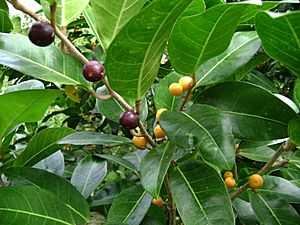
Ficus tinctoria, the coloring fig, is a type of "strangler fig." It's found in Malaysia, northern Australia, and the South Pacific islands.
The small, rust-brown fruit of this fig is used to make a red dye for traditional fabrics in parts of Oceania and Indonesia. The fruit is also edible and an important food source on the low-lying atolls of Micronesia and Polynesia.
Sweet Potato (Ipomoea batatas)
The sweet potato is another important crop. Its cultivation in Polynesia is a fascinating story of ancient connections across the Pacific.
Bottle Gourd (Lagenaria siceraria)
Noni (Morinda citrifolia)
Noni is native to Southeast Asia, New Guinea, and northern Australia. It grows easily on beaches and rocky areas. It was widely introduced to the Pacific. Austronesians used all parts of the plant for traditional medicine and wood. Its most common use was for making red or yellow dyes. People also believed the plant's smell could scare away evil spirits. The fruit is edible, but usually only eaten when other food is scarce.
Bananas (Musa species)
Bananas were first grown from wild plants in New Guinea before Austronesian speakers arrived. Banana remains have been found at the Kuk Swamp site, dating back 10,000 to 6,500 years ago. From New Guinea, cultivated bananas spread west to Island Southeast Asia. They mixed with other banana types in the Philippines and New Guinea. This mixing created the common banana types grown today. Austronesian people then spread these bananas during their voyages and trade routes to Oceania, East Africa, and South Asia.
These ancient bananas led to the group called "true plantains," found in East Africa and the Pacific. East African bananas came from bananas introduced to Madagascar. Pacific plantains came from eastern New Guinea or the Bismarck Archipelago.
Fe'i Banana (Musa × troglodytarum)
Fe'i bananas are special types of bananas found only in Melanesia, the Maluku Islands, and Polynesia. Unlike other bananas, fe'i bananas are believed to be mixes of completely different wild banana species from New Guinea and nearby islands. Like other bananas, they were spread east to Polynesia for food. However, they are not found in Island Southeast Asia, only reaching as far as the Maluku Islands.
Rice (Oryza sativa)
Rice is one of the oldest Austronesian staple foods. It was likely first grown by their ancestors long before the Austronesian expansion. It remains the main crop in Island Southeast Asia.
Rice farming and wet rice fields likely started in two main places. One was in the lower Yangtze River in China, believed to be the home of early Austronesian speakers. Their culture included stilt houses and boat building. They also ate acorns and raised pigs.
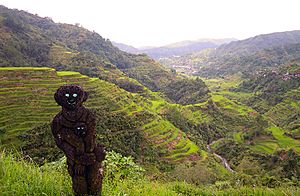
The other place was the middle Yangtze River. Both regions traded with each other, helping rice farming spread across southern China.
The spread of japonica rice to Southeast Asia began when Austronesian people from the Dapenkeng culture moved to Taiwan between 5,500 and 4,000 years ago. They brought rice and millet farming with them.
From about 4,000 to 2,500 years ago, the Austronesian expansion truly began. Settlers from Taiwan moved south to the Philippines, bringing rice farming. From the Philippines, Austronesians quickly settled the rest of Island Southeast Asia. By 2,500 years ago, wet rice farming was well established in Java and Bali.
However, rice (and dogs and pigs) did not survive the first Austronesian trips to Micronesia because of the long ocean distances. These travelers became the ancestors of the Lapita culture. By the time they reached the Bismarck Archipelago, they no longer farmed rice. But they used their knowledge of wet farming for taro. The Lapita culture later traded with other Austronesian groups and with non-Austronesian people in New Guinea. They learned about new fruits and tubers, and got pigs and dogs again, before spreading further east to Island Melanesia and Polynesia.
Rice was also brought to Madagascar, the Comoros, and the coast of East Africa around 1,000 years ago by Austronesian sailors.
Much later, Austronesian voyages brought rice to Guam during the Latte Period (1,100 to 300 years ago). Guam is the only island in Oceania where rice was grown before Europeans arrived.
Pandan (Pandanus species)
Pandanus plants are very important in the Pacific, second only to coconuts. Every part of the plant is used for food, building, medicine, and weaving. The fragrant flowers also had spiritual meaning in native Austronesian religions.

Pandanus was also crucial for the Austronesian expansion. Its leaves were woven into mats for the sails of Austronesian outrigger ships. These sails allowed long-distance voyages. If pandanus didn't grow in places like Rapa Nui and Aotearoa, it might have cut off those settlements from the rest of Polynesia.
The word for pandanus in Austronesian languages comes from *paŋudaN. This became *padran in Oceanic languages and *fara in Polynesian languages, often referring to Pandanus tectorius. Modern names include pandan in Tagalog and Malay, and hala in Hawaiian. In some Indigenous Taiwanese languages, the word shifted to mean "pineapple." In Māori, it shifted to other weaving plants because pandanus didn't survive in Aotearoa.
Pandanus grows well in island habitats, tolerating salt and easy to grow. They are common along beaches and in mangrove forests. They can also be found in forests on larger islands. Both pandanus and coconuts can withstand strong winds from typhoons. The greatest variety of Pandanus is in the western Pacific and Island Southeast Asia. There are about 600 species, but Pandanus tectorius is the most important.
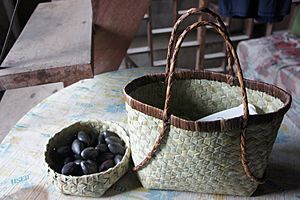
Pandanus tectorius in Oceania shows signs of long cultivation, with hundreds of different types bred by people. These types have different names and physical traits. They are mostly known by the color and edibility of their fruit, but also by their leaves for weaving.
Very old fossils of Pandanus tectorius in Hawaii date back over 1.2 million years. This means the plants naturally reached Hawaii (and other Pacific islands) by their floating fruits. However, useful domesticated types were carried by Austronesians from island to island. Wild pandanus fruits can cause itchiness if eaten raw, so domesticated types with fewer irritating crystals were valued. So, it's considered both native and introduced.
Peppers (Piper species)
Austronesians grew various peppers for food, medicine, and religious purposes. These included betel (Piper betle), cubeb pepper (Piper cubeba), kava (Piper methysticum), and Javanese long pepper (Piper retrofractum). Many others were gathered from the wild. Black pepper and long pepper were also grown a lot in Island Southeast Asia after traders from South India and Sri Lanka arrived.
Betel (Piper betle)
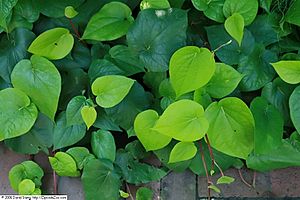
Betel is one of the main ingredients for betel chewing, along with the areca nut. It was a very common practice among Austronesians. People would take a betel leaf, wrap it around an areca nut and some lime (from crushed seashells), and chew it. It's a mild stimulant, causing slight dizziness and alertness. It also stains teeth red.
Betel chewing is strongly linked to Austronesian cultures. The oldest clear evidence of betel chewing is from the Philippines. Skeletons found in a burial pit in Palawan island, dating back about 4,630 years ago, had stained teeth, typical of betel chewers. The grave also had shells used for lime. It's believed betel chewing started in the Philippines shortly after the Austronesian expansion began. From there, it spread back to Taiwan and across the rest of Austronesia.
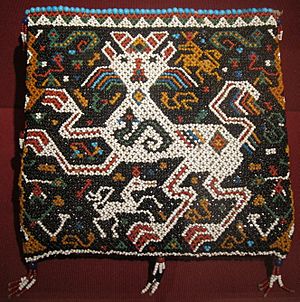
It reached Micronesia about 3,500 to 3,000 years ago. It was also present in the Lapita culture. But it didn't reach Polynesia further east. It's thought that it stopped in the Solomon Islands because people there started drinking kava instead. It also spread to East Africa with the Austronesian settlement of Madagascar and the Comoros.
The practice also spread to cultures that Austronesians traded with. It reached South Asia about 3,500 years ago through traders from Sumatra, Java, and the Malay Peninsula. It also spread to Mainland Southeast Asia and then north into China.
Kava (Piper methysticum)
Kava is a small tree or shrub believed to have been first grown in New Guinea or Vanuatu by Papuan people. It's thought to be a domesticated type of Piper subbullatum, which is native to New Guinea and the Philippines.
Austronesians spread kava to the rest of Polynesia after they came into contact with it. Kava is only found in Oceania and not in other Austronesian areas. Kava has great cultural and religious meaning for Polynesians. The roots are pounded and mixed with water. The cloudy liquid is bitter and has mild effects, like numbing the lips and mouth. It's used in social gatherings and religious rituals. Kava reached Hawaii, but it doesn't grow in Aotearoa (New Zealand).
Drinking kava is thought to be why betel chewing, which was common elsewhere, was lost among Austronesians in Oceania.
Sugarcane (Saccharum species)
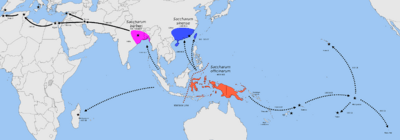
Sugarcane was domesticated in two places. One type, Saccharum officinarum, was grown by Papuan people in New Guinea. Another type, Saccharum sinense, was grown by Austronesian people in Taiwan and southern China. Both Papuans and Austronesians first used sugarcane as food for their pigs. The spread of both types of sugarcane is closely linked to the migrations of Austronesian peoples.
Saccharum officinarum was first grown in New Guinea. From there, it spread west to Island Southeast Asia after contact with Austronesians. It mixed with another type of sugarcane there.
The second place sugarcane was grown was in southern China and Taiwan. S. sinense was a major crop for Austronesian people from at least 5,500 years ago. The sweeter S. officinarum might have slowly replaced it in Island Southeast Asia. From Island Southeast Asia, S. officinarum was carried east to Polynesia and Micronesia by Austronesian sailors around 3,500 years ago. It also spread west and north to China and India around 3,000 years ago, where it mixed with other sugarcane types. From there, it spread further west to Europe and the Mediterranean.
Pacific Rosewood (Thespesia populnea)
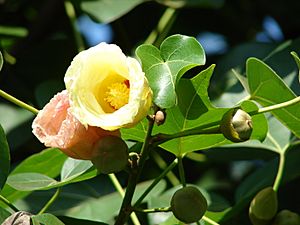
Pacific rosewood is similar to beach hibiscus and grows in the same places. It was used by Austronesian cultures for strong fibers to make ropes and for wood to build Austronesian outrigger ships and carvings. Pacific rosewood is native to the Old World tropics. Like beach hibiscus, its seeds can float for months. But since no remains of T. populnea were found in Polynesia before Austronesians arrived, it's believed that Austronesian settlers deliberately brought it there.
These trees were considered sacred in Polynesian culture. They were often planted in sacred sites along with other important trees.
Ginger Family (Zingiberaceae)
Gingers were widely grown by Austronesians for food, medicine, weaving, and religious purposes. Common types include lengkuas (Alpinia galanga), turmeric (Curcuma longa), and ginger (Zingiber officinale). Other types were gathered from the wild.
Lengkuas (Alpinia galanga)
Lengkuas is native to Southeast Asia. It was first grown a lot in Java for the spice trade. Today, it's still widely grown in Island Southeast Asia, especially in the Greater Sunda Islands and the Philippines. It's valued for food and traditional medicine. It has a strong smell like black pepper. Red and white types are used differently, with red ones mostly for medicine and white ones for spice. Lengkuas leaves are also used to make a traditional children's toy in Taiwan.
Turmeric (Curcuma longa)
There's strong evidence that turmeric and white turmeric were grown by Austronesian people independently. Turmeric is found everywhere Austronesians settled, except Taiwan. It was likely first grown to make dyes, which led to words for "yellow" and "red" in many Austronesian languages.
The plant is important in the Philippines and Indonesia for dyeing clothes and coloring food. It was especially valued for coloring food offerings to spirits and for body painting in religious ceremonies. It's also used as a spice, medicine, and food. Similar uses are found in other islands settled by Austronesians, including Madagascar and the Comoros. In Micronesia, it was a valuable trade item. In Polynesia and Melanesia, it's mainly used as body paint or a cosmetic.
Ginger (Zingiber officinale)
Ginger is native to Island Southeast Asia and was probably first grown by Austronesians. It's an ancient and common crop among Austronesians, reaching all the way to distant Oceania and Madagascar. Besides cooking, ginger seems to have had important religious and medicinal roles in early Austronesian cultures. Shamans would chew ginger and spit it out in rituals for healing, protection, and blessing ships.
Bitter Ginger (Zingiber zerumbet)
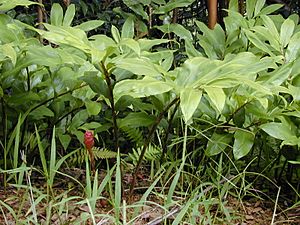
Bitter ginger is native to tropical Asia and Australasia. Like regular ginger, Austronesian settlers carried it all the way to distant Oceania in ancient times. So, it was likely first grown by Austronesians. Remains of bitter ginger have been found at the Kuk Swamp site in New Guinea, dating back over 10,000 years. It's not known if they were grown or just gathered from the wild.
Bitter ginger is mainly used for traditional medicine. It also has mild effects when eaten, so it was important in early Austronesian rituals. The old word for bitter ginger, *kawaRi, which meant "bitter root" or "strong root (used as fish poison)," is believed to have been transferred to kava (Piper methysticum). Kava has similar properties and is also bitter, and Austronesians of the Lapita culture found it among the native people in Melanesia.
Animals Carried by Austronesian Voyagers
Austronesian travelers also carried important animals with them. These animals helped them survive and build new communities.
Water Buffalo (Bubalus bubalis)
Water buffaloes are very important work animals for farming rice fields. They were brought to Island Southeast Asia from mainland Asia along with rice. Early buffaloes were the swamp type, like the carabao.
The oldest signs of domesticated water buffaloes in Island Southeast Asia come from the Philippines, dating back at least 500 BCE. These remains were found with pottery and tools similar to those from ancient Austronesian sites in Taiwan.
The English word "carabao" comes from a Spanish word, which came from a Visayan language word, karabàw. Other similar words for buffalo are found in many Austronesian languages.
Dogs (Canis lupus familiaris)
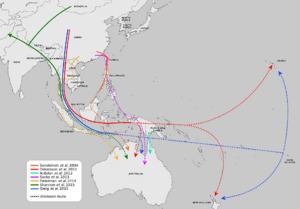
Dogs were valued by Austronesian cultures as companions and pets. They were also trained for hunting or guarding. Ornaments made from dog fur, teeth, and bones are found in old sites. Dogs were sometimes eaten, but this varied among different cultures.
The origin of dogs in Island Southeast Asia, Australia, and New Guinea is debated. Most experts agree there were at least two times dogs were introduced. One wave came with ancient hunter-gatherers, and another with later farming and trading cultures, including Austronesians. These later dogs could digest starch, showing they traveled with people who grew grain crops.
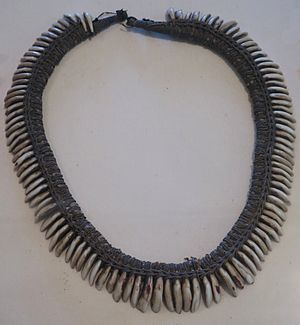
The oldest dog remains in Island Southeast Asia are from Timor, dating back about 3,500 years ago. From Island Southeast Asia, dogs were carried by Austronesian sailors to Near Oceania. Dogs were rare in Lapita culture sites, possibly because they were less useful on small islands. However, dogs were later carried east to Polynesia by post-Lapita Austronesian migrations, reaching as far as Hawaii and Aotearoa.
Some Pacific islands did not have dogs, or the dogs died out, such as the Mariana Islands, Palau, and Easter Island. Dogs were not introduced to Madagascar by Austronesians.
Chickens (Gallus gallus)
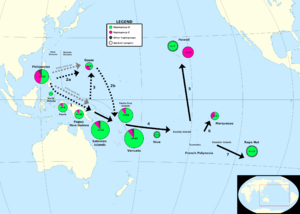
Chickens were one of the three main animals (along with pigs and dogs) carried by early Austronesian peoples from Island Southeast Asia on their voyages to the islands of Oceania.
Pigs (Sus scrofa domesticus)
Pigs were one of the three main animals (along with chickens and dogs) carried by early Austronesian peoples from Island Southeast Asia on their voyages to the islands of Oceania.
Rodents
Polynesian Rat (Rattus exulans)
This rat came from the island of Flores in Indonesia. Polynesians accidentally or on purpose brought it to the islands they settled. This rat has caused many native birds and insects in the Pacific to become extinct. These species had evolved without mammals and couldn't protect themselves from the rats.
Images for kids
-
Wax gourds being sold in Indonesia
-
Job's tears with developing seed pods
-
Fruit of Cucumis melo
-
Ficus nota in Hawaii
-
Ficus tinctoria in Vava'u, Tonga
-
Indian nightshade in Alakode
Category:History of agriculture in the Lake Tana]] Category:History of agriculture in the Lake Victoria]] Category:History of agriculture in the Lake Volta]][[Category:History of agriculture in the Lake
See also
 In Spanish: Plantas y animales domesticados de Austronesia para niños
In Spanish: Plantas y animales domesticados de Austronesia para niños


